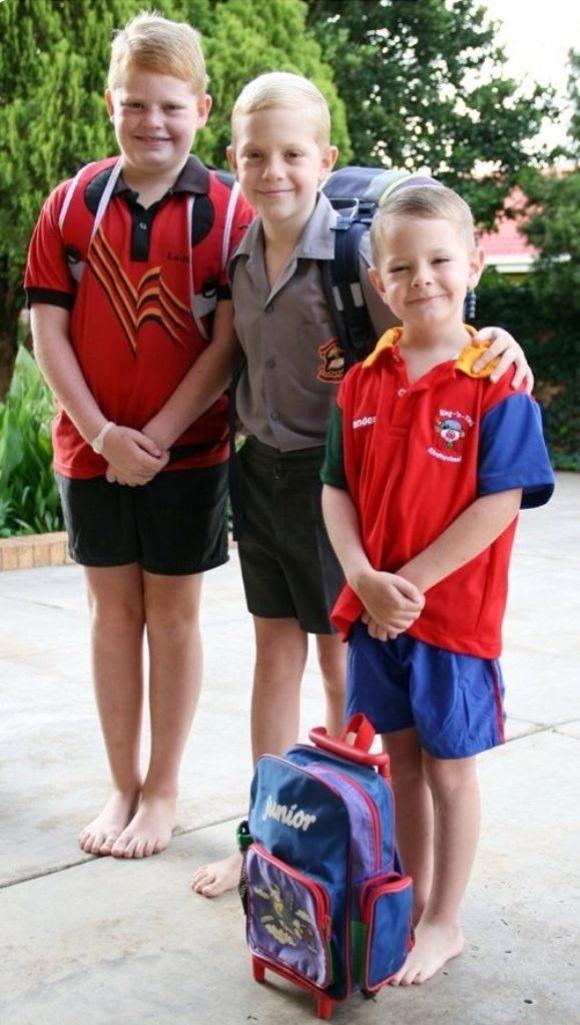
South African School Uniform: School Types--Sponsorship

Figure 1.--These brothers are from Klerksdorp, North West Province. It shows Quintus, Jason, and Zander De Bruyn. They are leaving home on their first schoolday in 2010. Zander, who was 5, attended the preschool. I don't know the name of the school.
Both Quintus (10) and Jason (8) attended Laerskool La Hoff, a public primary school in the township of La Hoff (city of Klerksdorp).
In the school there are two different uniforms. The boys have a regular summer uniform of grey short sleeves shirt and grey short pants with optional grey socks and black shoes. They have also a casual uniform of black shorts and polo shirt with the school name. In the school prospectus we can read: "The pupils from grade 1 to 4 are encouraged to come to school barefoot".
|
|
The basic division is of course primary and secondary schools. We are not sure how primary children dresses for school in the 19th and early 20th centuries. I think that uniforms were generally not required, but have little information. Elementary children at state schools have generally worn shorts since the 1920s, often going barefoot. In the cooler weather, knee socks were worn to school. Many primary schools currently require uniforms. Often the regulation is short pants in the summer and long pants in the winter. Often a sweater ("jumper") or sweat shirt is worn as part of the uniform. Blazers and ties are rarely required. Many secondary schools followed English dress standards through the 1950s. Trends can vary between urban and rural schools. The South African Government promotes uniforms even in rural schools. A good example of a rural school is an unidentified school about 2006. It was not uncommon for state secondary schoolboys to wear wear caps, ties, blazers, shorts, and knee socks. The academically selective grammar school tended to have the strictest dress codes as they often attempted to emulate the ethos of the English public school. This began to change in the 1950s and especially the 1960s. Some state secondary schools dropped uniform requirements all together. Most retained a basic uniform. Currently uniforms continue to be common. Many schools have a summer and winter uniform. Often shorts are worn in the summer term. Some schools require knee socks, but many do not. The styles are currently much more casual than in earlier years. Open neck shirts are most common and ties are now rarely worn.
HBC-SU

Related Chronolgy Pages in the Boys' Historical Web Site
[Main Chronology Page]
[The 1900s]
[The 1910s]
[The 1920s]
[The 1930s]
[The 1940s]
[The 1950s]
[The 1960s]
[The 1970s]
Navigate the Relate Boys Historical Clothing Style Pages
[Main country page]
[Long pants suits]
[Short pants suits]
[Lederhosen]
[Kneesocks]
[Eton suits]
[Jacket and trousers]
[Blazer
[School sandals]
Navigate the Boys' Historical Clothing School Uniform Pages
[Main South African school page]
[Main School Uniform Page]
[Main National School Uniform Page]
[Australia]
[England]
[France]
[Germany]
[Ireland]
[Italy]
[Japan]
[New Zealand]
[Poland]
[Scotland]
[United States]
Navigate the Boys' Historical Clothing Web Page
[Return to the South African school type]
[About Us]
[Activities]
[Chronology]
[Clothing styles]
[Countries]
[Debate]
[Economics]
[Garment]
[Gender]
[Hair]
[History]
[Home trends]
[Literary characters]
[School types]
[Significance]
[Transport and travel
[Uniform regulations]
[Year level]
[Other topics]
[Images]
[Links]
[Registration]
[Tools]
[Return to the Historic Boys' School Home]
Created: 9:30 AM 7/5/2015
Last updated: 9:30 AM 7/5/2015




